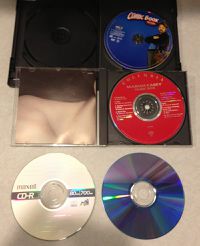Optical Discs
From Just Solve the File Format Problem
An optical disc is read by a laser. They have been used extensively to store and distribute music, movies, and computer programs and data. CD drives became commonplace in personal computers in the mid-1990s, and burners to create CD-ROMs on personal computers were common by the early 2000s. Later, the higher-capacity DVD format became common both for reading and writing as well, and the even newer BluRay format won a "format war" against rival HD-DVD to get some popularity at present, though physical formats in general are on the wane as a distribution format due to the widespread deployment of the high-bandwidth Internet.
See also:
List of formats
- Blu-ray Disc
- CD (Compact Disc)
- DVD
- Enhanced Versatile Disc
- GD-ROM
- HD-DVD
- Laserdisc
- MiniDisc
- Nintendo optical discs
- Thomson-CSF system
- Ultra Density Optical
- Universal Media Disc
- IBM 3363 Optical WORM
Links
- Optical media longevity
- "Archival Disc" standard formulated for professional-use next-generation optical discs (up to 1 TB capacity)
- An Introduction to Optical Media Preservation by @archivetype
- Library of Congress Recommended Format Specifications: Software/Gaming
- Developing a Robust Migration Workflow for Preserving and Curating Hand-held Media
- 5D nanostructured quartz glass optical memory could provide ‘unlimited’ data storage for a million years (but reference link there is already 404 Not Found!)
- Preserving optical media from the command line
